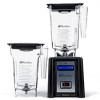Blendtec Professional Series Owners Manual - Page 15
Troubleshooting, Blender Motor Will Not Turn On, Look At The Lcd, Noise Level Changes
 |
View all Blendtec Professional Series manuals
Add to My Manuals
Save this manual to your list of manuals |
Page 15 highlights
SECTION 7 TROUBLESHOOTING 7.1 BLENDER MOTOR WILL NOT TURN ON If the blender motor will not turn on, try the following: • Make sure the main power switch on the front panel is turned ON. • Check your house circuit breaker switch or fuse to make sure it is set to the ON position. • Unplug the power cord from the wall receptacle, wait 5 seconds, then plug power cord back in. • Determine if the Liquid Crystal Display (LCD) is lit. An absence of a lit LCD indi- cates a lack of power to the unit. • Remove the blender jar from the blender motor and check to make sure the blade turns freely while unattached to the motor. If the blade does not move freely the problem may be the jar, not the motor. Check the jar by turning the shaft by hand to see if it rotates easily. Look at the LCD: • A reading of "OVERTEMP" indicates that the motor is overheating. The blender has been disabled until the unit cools to operating temperatures. Turn off and unplug the unit. Allow it to cool for at least 20 minutes. • A reading of "OVERLOAD" indicates an overload on the motor. Turn off and unplug the unit. Plug in the unit and turn the motor on again to clear the overload condition. Check the blender jar for blockage. If overload condition re-occurs, contact your Blendtec service agent. • Blade stops: If the overload switch stops the blender, remove the blender jar and carefully check for blockage of the blade. If no blockage is found, replace jar and use the Pulse button on the touch pad to quickly pulse the blade through the mixture. Once the blade spins freely a programmed button may be used. 7.2 NOISE LEVEL CHANGES If the blender noise level has increased significantly from original levels, determine whether the sound is coming from the blender motor or jar. • Blender Motor: Check to see if the excess noise is coming from the blender base. Remove the jar and press cycle number two or three. Listen to the motor sound without a jar attached. If it is excessively noisy contact your Blendtec service center. • Jar: Check to see if the excess noise is coming from the jar. Place the jar back on the motor. Run the motor for a few seconds using the Pulse button. If you have more than one jar, test a different jar to determine whether the sound changes as different jars are used. If a jar is excessively noisy, or if the blade assembly seems loose or sounds "gravelly" when turned by hand, contact your Blendtec service center. CN-12















